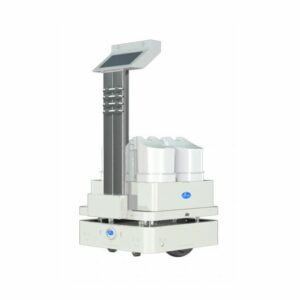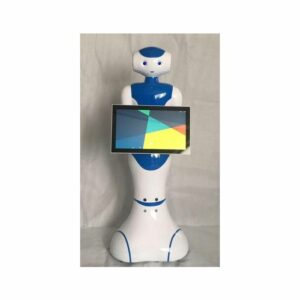AI-TECH Emma 1 Companion Robot
$13,599.99Emma 1 cannot wait to meet you and be your robot companion! She learns your interests, likes and dislikes from each interaction to provide you with a more pleasing experience.
Robotics engineering , In today’s rapidly advancing world, robotics engineering has emerged as a groundbreaking field that has the potential to reshape various industries and revolutionize the way we live. From autonomous vehicles to robotic surgery, the applications of robotics are expanding at an unprecedented pace. This article delves into the fascinating world of robotics engineering, exploring its significance, advancements, challenges, and future prospects.
Robotics engineering is a multidisciplinary field that combines principles of mechanical engineering, electrical engineering, and computer science to design, construct, and operate robotic systems. These systems are created to mimic human actions, perform tasks autonomously, or assist humans in various domains.
The roots of robotics engineering can be traced back to ancient times when inventors and scientists explored the idea of creating mechanical beings. However, the modern era of robotics began in the mid-20th century, with the development of the first industrial robot by George Devol and Joseph Engelberger. Since then, robotics has made significant strides, paving the way for advanced technologies such as artificial intelligence and machine learning.
Robotics systems consist of several key components, including mechanical structures, sensors, actuators, and control systems. The mechanical structure provides the framework for the robot, while sensors enable it to perceive and interact with its environment. Actuators are responsible for executing physical movements, and the control system governs the robot’s behavior and decision-making.
Robotics engineering has transformed various industries by enhancing efficiency, productivity, and safety. In manufacturing, robots have revolutionized assembly lines and repetitive tasks, leading to higher precision and reduced human error. Additionally, industries such as automotive, electronics, and aerospace have extensively adopted robotics to streamline production processes.
The healthcare sector has witnessed remarkable advancements with the integration of robotics. Surgical robots, for instance, assist surgeons in performing minimally invasive procedures with improved precision and dexterity. Robotic exoskeletons have also emerged as valuable tools for rehabilitation and assisting individuals with mobility impairments.
Automation in agriculture is another area where robotics engineering has made significant contributions. Agricultural robots are designed to perform tasks like planting, harvesting, and monitoring crop health. These robots not only improve efficiency but also enable sustainable practices by optimizing resource usage and reducing chemical inputs.
In the manufacturing industry, robots have become an indispensable asset. They excel in tasks that require speed, precision, and consistency, ensuring high-quality production. Collaborative robots, known as cobots, work alongside humans, enhancing safety and efficiency in manufacturing facilities.
Autonomous vehicles are a prime example of the convergence of robotics and artificial intelligence. Robotics engineering plays a crucial role in developing self-driving cars, trucks, and drones. These vehicles rely on a combination of sensors, algorithms, and control systems to navigate their surroundings without human intervention.
Despite remarkable progress, robotics engineering faces various challenges. One major hurdle is the development of robots that can adapt to dynamic and unstructured environments. Additionally, ensuring the safety and ethical use of robots remains a significant concern. Addressing these challenges requires ongoing research and collaboration across disciplines.
As robots become more integrated into our daily lives, ethical considerations come to the forefront. Questions regarding privacy, job displacement, and the potential misuse of robotic systems need careful examination. It is crucial to establish guidelines and regulations to ensure responsible and beneficial deployment of robots.
The future of robotics engineering holds immense possibilities. Advancements in artificial intelligence, machine learning, and sensor technologies are expected to enable robots to become more intuitive, adaptive, and capable of human-like interactions. Swarm robotics, soft robotics, and bio-inspired designs are among the emerging trends that will shape the field.
The integration of robotics in industries has raised concerns about job displacement. However, history has shown that technological advancements often create new opportunities. While some job roles may change, robotics engineering is also creating a demand for skilled professionals who can design, program, and maintain robotic systems.
Robotics has played a pivotal role in space exploration. Robotic rovers and landers have been deployed to explore distant planets and moons, gathering valuable data and expanding our understanding of the universe. These robotic missions have paved the way for future human exploration and colonization efforts.
Artificial intelligence (AI) and robotics are closely intertwined. AI algorithms enable robots to learn from their environment, make decisions, and adapt to new situations. Machine learning techniques empower robots to enhance their performance over time, making them more efficient and capable of complex tasks.
Robotics engineering has emerged as a transformative discipline, shaping the future across various sectors. From manufacturing to healthcare, agriculture to space exploration, robots are enhancing efficiency, safety, and human capabilities. However, addressing ethical concerns and embracing responsible deployment will be crucial as robotics continues to evolve.
1. Are robots replacing human workers? While robots are automating certain tasks, they also create new job opportunities in robotics engineering and related fields. Humans and robots can work collaboratively, leveraging the strengths of both.
2. How safe are robotic systems in healthcare? Robotic systems in healthcare undergo rigorous testing and adhere to strict safety standards. Surgeons and healthcare professionals receive specialized training to operate these systems safely.
3. Can robots think like humans? While robots can simulate certain human-like behaviors, they do not possess consciousness or emotions. Robots rely on programmed algorithms and data to perform tasks.
4. What are some future applications of robotics? Future applications of robotics include space exploration, household assistance, eldercare, disaster response, and advancements in prosthetics and assistive devices.
5. How can individuals pursue a career in robotics engineering? Individuals interested in a career in robotics engineering can pursue relevant academic programs in engineering, computer science, or robotics. Hands-on experience and continuous learning are also essential.
Showing 1–20 of 64 results

Emma 1 cannot wait to meet you and be your robot companion! She learns your interests, likes and dislikes from each interaction to provide you with a more pleasing experience.

Emma 2 cannot wait to meet you and be your robot companion! She learns your interests, likes and dislikes from each interaction to provide you with a more pleasing experience.

Emma 3 cannot wait to meet you and be your robot companion! She learns your interests, likes and dislikes from each interaction to provide you with a more pleasing experience.

Emma 5 cannot wait to meet you and be your robot companion! She learns your interests, likes and dislikes from each interaction to provide you with a more pleasing experience.

Emma 7 cannot wait to meet you and be your robot companion! She learns your interests, likes and dislikes from each interaction to provide you with a more pleasing experience.

Emma 8 cannot wait to meet you and be your robot companion! She learns your interests, likes and dislikes from each interaction to provide you with a more pleasing experience.

Emma 9 cannot wait to meet you and be your robot companion! She learns your interests, likes and dislikes from each interaction to provide you with a more pleasing experience.

Based on a new-generation fully-autonomous positioning and navigation system, the Intelligent Food Delivery Robot uses laser technology and multiple sensors to deliver dishes from the kitchen to the table.

The Spray Disinfection Robot works autonomously to sterilize any location, navigating a specific area while spraying disinfectant liquid using its unique atomizer technology.

The programmable UV Disinfection Robot uses concentrated ultraviolet rays to kill bacteria and other harmful micro-organisms without manual intervention.

Discover the unlimited possibilities robot receptionist/greeter Eve has to offer. She can learn how to perform any task with easy-to-use software.

Bring your non-moving companion robot to life with the Eden Robotics Exoskeleton. Now even your lifeless silicone doll can perform human-like activities on it’s own!

Companion robot Foxi is the next technological frontier in personal robotics. She can be your own household maid, lover, companion, and anything else you want her to be.

Companion robot Harley is the next technological frontier in personal robotics. She can be your own household maid, lover, companion, and anything else you want her to be.

Companion robot Jeni is the next technological frontier in personal robotics. She can be your own household maid, lover, companion, and anything else you want her to be.

Discover the unlimited possibilities robot receptionist/greeter Lexi has to offer. She can learn how to perform any task with easy-to-use software.

Market and advertise like never before with this fashionable robot mannequin. Eden Robotics Mari Interactive Robot Mannequin not only displays your brand or products, but will greet, guide, make suggestions, and entertain customers entering your store.

Companion robot Mimi is the next technological frontier in personal robotics. She can be your own household maid, lover, companion, and anything else you want her to be.

Intelligent humanoid robot receptionist, greeter and hotel concierge can provide information and guidance for customers and guests.

Let the Smart Robot Greeter be the face of your business. It can welcome customers, offer guidance, make sales and perform clerical duties.